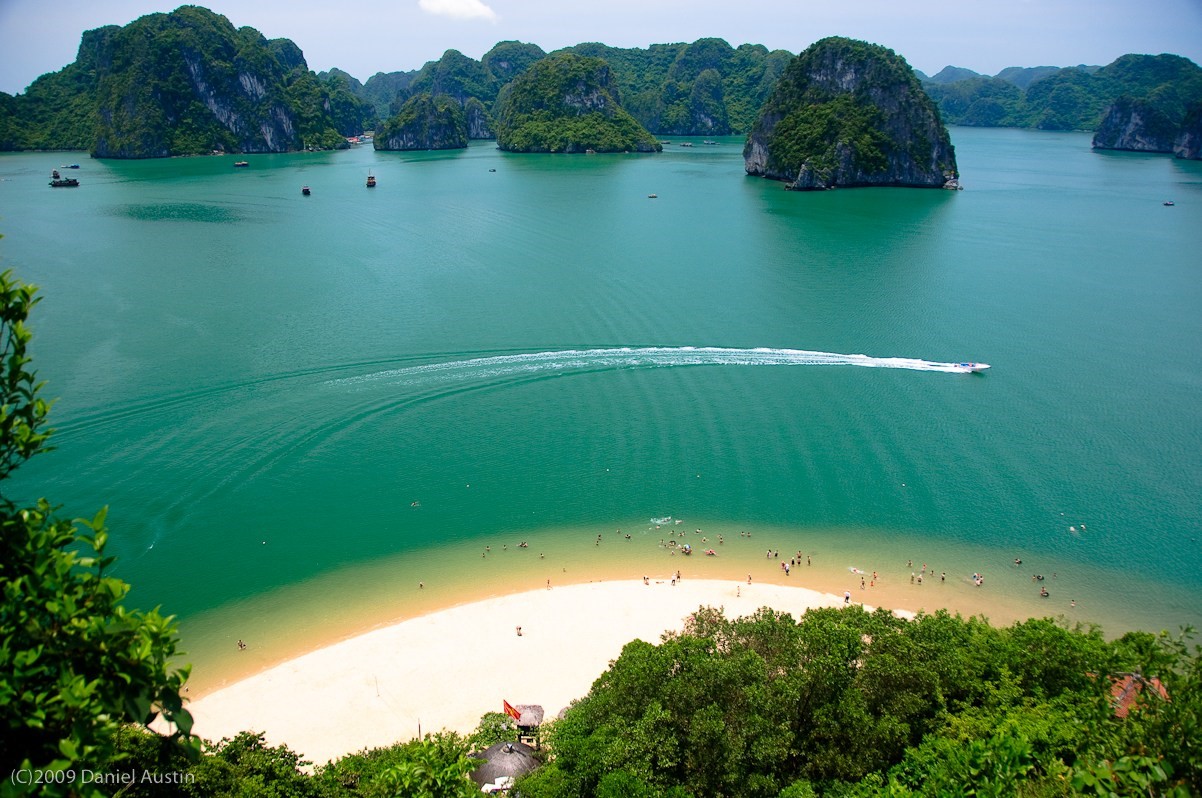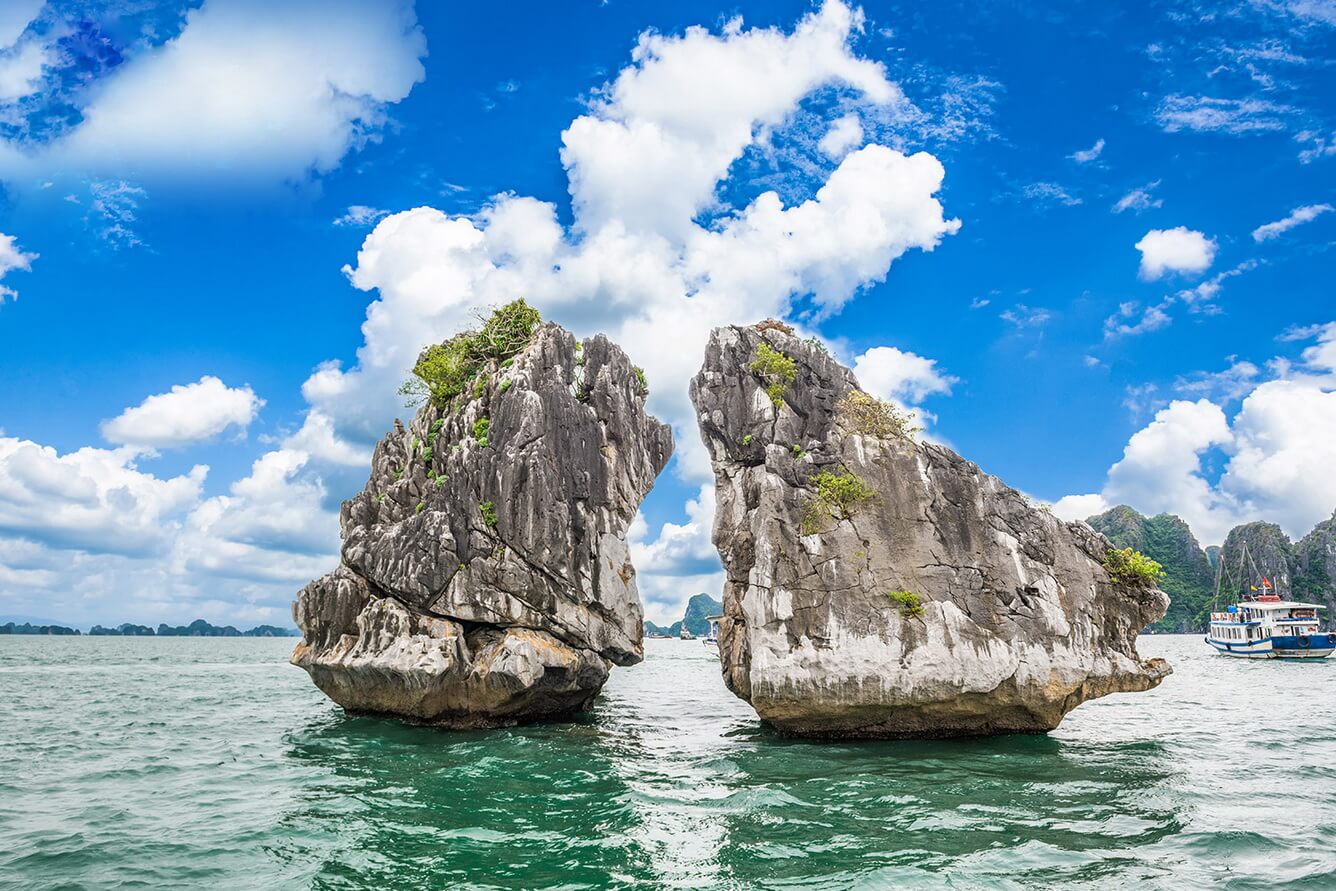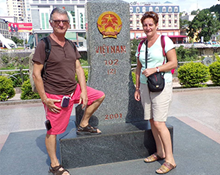- Home
- OUR ITINERARIES
- GUIDEBOOK
- VIETNAM HISTORY
- USEFUL INFORMATIONS
- BEFORE DEPARTURE
- VISIT HA LONG BAY BY SEAPLANE
- MOST BEAUTIFUL BEACHS IN VIETNAM
- GEOGRAPHY & CLIMATE IN VIETNAM
- VIETNAM CULTURE
- NIGHT IN HOMESTAY
- CRUISING IN VIETNAM
- ACCOMMODATION & ADVISES
- BEACH, SNORKELING & DIVING HOLIDAY
- TRAVEL WITH FAMILY
- GOLF
- DOMESTICS FLIGHTS
- OFF THE BEATEN TRACK TOUR
- SITES TO DISCOVER
- ABOUT US
- CUSTOMIZED TOUR
Ha-Long Bay
Ha-Long Bay in the Gulf of Tonkin has around 1,600 islands and islets that create a spectacular seascape of limestone pillars. Due to the vertiginous relief, most of the islands are uninhabited and undisturbed by humans.

Outstanding Universal Value
Brief synthesis
Ha Long Bay, located in the Gulf of Tonkin, Quang Ninh Province, northeast Vietnam, is 165 km from the capital city of Hanoi. Covering an area of 43,400 ha and comprising more than 1,600 islands and islets, most of which are uninhabited and have not been disturbed by human activity, the bay forms a spectacular marine panorama of limestone pillars and represents a perfect model of the landscape. mature karst, as it evolves in a tropical, hot and humid climate. In addition to the exceptional scenic beauty of the site, there is great biological interest in it.
The exceptional value of the site is centered on the submerged limestone karst formations, rising in remarkable pillars that present a variety of coastal erosion features such as arches and caves, which constitute a landscape of natural majesty. The repeated regression and progression of the sea over the limestone karst, through geological periods, has produced a fully developed landscape of groups of conical peaks and isolated turrets, modified by the invasion of the sea. This brought a new element to the phenomenon of lateral scouring of turrets and limestone islands.
Criterion (vii): Comprising a multitude of limestone islands and islets emerging from the sea, of various sizes and shapes, and presenting a picturesque and unspoiled nature, Ha-Long Bay is a remarkable seascape, sculpted by nature. The site retains a high degree of natural beauty and, despite its long history of human exploitation, is not seriously degraded. The exceptional elements of the site include the magnificent gigantic pillars, and associated notches, arches and limestone caves, whose evolution is unusual and which are among the most panoramic of their type in the world.
Criterion (viii): As the world's most extensive and best-known example of sea-invaded karst turrets, Ha-Long Bay is one of the most significant areas of Fengcong (groups of conical shape) and Fenglin (isolated turrets) karst. An abundance of lakes in submerged sinkholes, some of which appear to be subject to tides, are one of the hallmarks of karst fengcong. The bay is characterized by an astounding diversity of caves and other landforms created by the unusual phenomenon of the invasion of a turreted karst by the sea. The caves are divided into three main types: remains of phreatic caves, d ancient karst caves formed at the foot of cliffs, and marine notches. The site also offers the full range of karst formation phenomena, which occur on a very large scale and during great geological eras; it has the most complete and richest example of its type in the world and constitutes a vast and exceptional reservoir of data which will serve to better understand the geoclimatic history and the nature of karst phenomena in a complex environment.
The exceptional geological features of Ha Long Bay are included within the boundaries of the site, the size and area of which possess the integrity necessary for the evolution of large-scale geomorphological phenomena without hindrance. The site benefits from the fact that it is entirely surrounded by a buffer zone of significant width and extent, and the size and area of which provide the integrity necessary for the free development of large-scale geomorphological phenomena.
Located in an area of great tourism, maritime transport, fishing, and daily and commercial activities carried out by its residents, Ha Long Bay is an area whose management has been established since the site was inscribed. Strict regulation and control of activities are applied there in order to minimize the impact on the integrity of the environment. The challenge to improve the integrity and quality of the environment is ongoing. The natural beauty of the landscape, geomorphology, its interest in geological formations and as cultural heritage, as well as key features such as islands, caves and caves remain intact, with the site retaining a high level of natural beauty despite a long history of human use of the area.
Protection and management requirements
Ha Long Bay was listed as a Historical and Cultural Vestige and designated a National Landscape Site in 1962. Subsequently designated a Special National Landscape Site under the Heritage Act
cultural amended in 2009, the site is the property of the provincial government. The site is adequately protected by a number of relevant provincial and national laws, as well as government decrees including the following: Cultural Heritage Law, Biodiversity Law, Tourism Law, Environmental Protection Law , Fisheries Law and Maritime Transport Law. Under these laws, any action proposed within the site that may have a significant impact on its values must be the subject of an official authorization from the Ministry of Culture, Sports and Tourism, as well as from other relevant ministries.
The Ha Long Bay Management Department was established after its inscription on the World Heritage List and has the main functions of management, conservation and promotion of the values of the site. The department takes into account the requirements of the World Heritage Convention, recommendations of the World Heritage Committee and other regulations issued by both the Vietnamese government and Quang Ninh province. Day-to-day management requires collaboration with certain stakeholders at different levels, particularly local communities, in order to maintain the integrity of the site and monitor its socio-economic activities.
The socio-economic activities of Ha Long Bay are well regulated, scrupulously observed and effectively managed. Management and protection are further strengthened by regulations, master plans and action plans at the provincial level. These include regulations covering the operation of tourist boats, mud dredging, dumping, fishing and the management of floating dwellings. They also provide education and promotion and sensitize communities to heritage properties and their conservation. There are several specific plans for environmental protection, tourism development, and management and conservation planning, including, "Ha-Long Bay until 2020", conservation, management master plan. and the development of World Natural Heritage values, approved by the Prime Minister in 2001, and the integrated management plan for the World Heritage site of Ha-Long Bay 2010-2015, approved by the provincial body in 2010.
In the long term, the management of the site will focus on the following points: ensuring the integrity of the landscape, geological and geomorphological values, as well as the environment, strengthening of legislative provisions, careful monitoring of socio-economic activities in Ha Long Bay, increasing the use of technology for heritage management, initiating research to better understand the values of the site, improving staff training and improving awareness and involvement of community members.
The increase in the number of visitors and the ensuing consequences continue to have an impact on the management of the site. The sensitivity displayed as well as the attention paid to aesthetic quality and public safety with regard to the infrastructure - walkways, steps and wooden paths - are great, and the significant increase in the number of visitors requires improvement. corresponding to the quality of visitor management. The development pressures associated with the increasing number of tourists continue to be felt on government authorities, and an appropriate balance between conservation and development, although difficult to find, is important in order to ensure the protection of the natural values of the site.
Informations
GUIDEBOOK
AVANT LE DEPARTAdd: Quat Dong, Thuong Tin, Ha Noi INTERNATIONAL TOURISM LICENSE
Tel / whatsapp : +84 976 255 369 No : 01-1157/2018/ TCDL-LHQT
ZEN VIETNAM TRAVEL, A Branch of Thuong Tin Tourist
© Copyright from ZEN VIETNAM TRAVEL
















